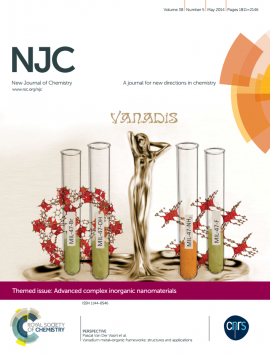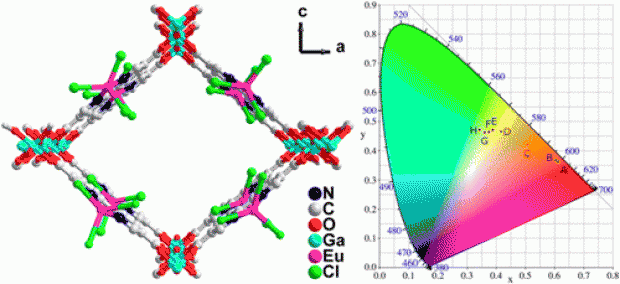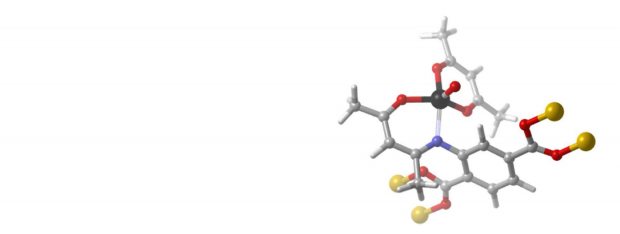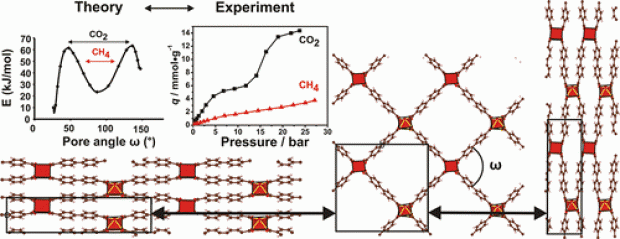Y-Y Liu
A series of sulfonic acid functionalized mixed-linker DUT-4 analogues: synthesis, gas sorption properties and catalytic performance
Abstract
In this work, we present the successful synthesis of a series of sulfonic acid functionalized mixed-linker metal–organic frameworks (MOFs) having the DUT-4 topology by using different ratios of 2,6-naphthalenedicarboxylic acid (H2-NDC) and 4,8-disulfonaphthalene-2,6-dicarboxylic acid (H2-NDC-2SO3H) in one-pot reactions. The obtained materials were fully characterized and their CO2 adsorption properties at low and high pressures were studied and compared with those of the pristine DUT-4 material. Generally, the CO2 adsorption capacities range from 3.28 and 1.36 mmol g−1 for DUT-4 to 1.54 and 0.78 mmol g−1 for DUT-4-SO3H (50) up to 1 bar at 273 K and 303 K, respectively. Computational calculations corroborated the structural changes of the material in function of the loading of sulfonic acid groups. Furthermore, due to the strong Brønsted acid character, the resulting sulfonic acid based MOF material was evaluated as a catalyst for the ring opening of styrene oxide with methanol as a nucleophile under mild conditions, showing almost full conversion (99%) after 5 hours of reaction. A hot filtration experiment demonstrated that the catalysis occurred heterogeneously and the catalyst could be recovered and reused for multiple runs without significant loss in activity and crystallinity.
Vanadium Metal-Organic Frameworks: Structures and Applications

Abstract
This perspective review paper describes the V-containing Metal-Organic Framworks that have been developed since the first systematic reports on MOFs almost 15 years ago. These hybrid crystalline materials, containing V(III) or V(IV) as metal nodes show interesting behaviour in oxidation catalysis and gas sorption. A significant amount of papers has appeared on the use of these structures in gas (hydrocarbon, CO2) separation. Promising future research and development of V-MOFs is suggested.
 Open Access version available at UGent repository
Open Access version available at UGent repositoryNew Functionalized Metal–Organic Frameworks MIL-47-X (X = −Cl, −Br, −CH3, −CF3, −OH, −OCH3): Synthesis, Characterization, and CO2 Adsorption Properties
Abstract
Six new functionalized vanadium hydroxo terephthalates [VIII(OH)(BDC-X)]•n(guests) (MIL-47(VIII)-X-AS) (BDC = 1,4-benzenedicarboxylate; X = -Cl; -Br, -CH3, -CF3, -OH, -OCH3; AS = as-synthesized) along with the parent MIL-47 were synthesized under rapid microwave-assisted hydrothermal conditions (170 ºC, 30 min, 150 W). The unreacted H2BDC-X and/or occluded solvent molecules can be removed by thermal activation under vacuum leading to the empty-pore forms of the title compounds (MIL-47(VIV)-X). Except pristine MIL-47 (+III oxidation state), the vanadium atoms in all the evacuated functionalized solids stayed in +IV oxidation state. The phase purity of the compounds was ascertained by X-ray powder diffraction (XRPD), diffuse reflectance infrared Fourier transform (DRIFT) spectroscopy, Raman, thermogravimetric (TG), and elemental analysis. The structural similarity of the filled and empty-pore forms of the functionalized compounds with the respective forms of parent MIL-47 was verified by cell parameter determination from XRPD data. TGA and temperature-dependent XRPD (TDXRPD) experiments in air atmosphere indicate high thermal stability in the range 330-385 ºC. All the thermally activated compounds exhibit significant microporosity (SLangmuir in the range 418-1104 m2 g-1), as verified by the N2 and CO2 sorption analysis. Among the six functionalized compounds, MIL-47(VIV)-OCH3 shows the highest CO2 uptake, demonstrating the determining role of functional groups on the CO2 sorption behaviour. For this compound and pristine MIL-47(VIV), Widom particle insertion simulations were performed based on ab initio calculated crystal structures. The theoretical Henry coefficients show a good agreement with the experimental values, and calculated isosurfaces for the local excess chemical potential indicate the enhanced CO2 affinity is due to two effects: (i) the interaction between the methoxy group and CO2 and (ii) the collapse of the MIL-47(VIV)-OCH3 framework.
Mn-salen@MIL101(Al) a heterogeneous, enantioselective catalyst using a ‘bottle around the ship’ approach
Abstract
An enantioselective catalyst, consisting of a chiral Mn(III)salen complex entrapped in the MIL-101 metal organic framework is reported. For the first time, we assemble a robust MOF-cage around a delicate chiral complex, without affecting the structure and stability of this complex. The newly prepared heterogeneous catalyst shows the same enantioselective excess compared to the homogeneous Mn(III)salen complex and is fully recyclable. Theoretical calculations yield insight into the dimensions of the various transition states of the epoxidation reaction.
Bimetallic–Organic Framework as a Zero-Leaching Catalyst in the Aerobic Oxidation of Cyclohexene
Abstract
A gallium 2,2′-bipyridine-5,5′-dicarboxylate metal–organic framework (MOF), denoted as COMOC-4, has been synthesized by solvothermal synthesis. This MOF exhibits the same topology as MOF-253. CuCl2 was incorporated into COMOC-4 by a post-synthetic modification (PSM). The spectroscopic absorption properties of the MOF framework before and after PSM were compared with theoretical data obtained by employing molecular dynamics combined with time-dependent DFT calculations on both the as-synthesized and functionalized linker. The catalytic behavior of the resulting Cu2+@COMOC-4 material was evaluated in the aerobic oxidation of cyclohexene with isobutyraldehyde as a co-oxidant. In addition, the catalytic performance of Cu2+@COMOC-4 was compared with that of the commercially available Cu-BTC (BTC=benzene-1,3,5-tricarboxylate) MOF. Cu2+@COMOC-4 exhibits a good cyclohexene conversion and an excellent selectivity towards cyclohexene oxide in comparison to the Cu-based reference catalyst. Furthermore, no leaching of the active Cu sites was observed during at least four consecutive runs.
Bipyridine-Based Nanosized Metal–Organic Framework with Tunable Luminescence by a Postmodification with Eu(III): An Experimental and Theoretical Study

Abstract
A gallium 2,2′-bipyridine-5,5′-dicarboxylate metal-organic framework, Ga(OH)(bpydc), denoted as COMOC-4 (COMOC = Center for Ordered Materials, Organometallics and Catalysis, Ghent University) has been synthesized via solvothermal synthesis procedure. The structure has the topology of an aluminum 2,2′-bipyridine-5,5′-dicarboxylate, the so-called MOF-253. TEM and SEM micrographs show the COMOC-4 crystals are formed in nanoplates with uniform size of 30-50 nm. The UV-Vis spectra of COMOC-4 in methanol solution show maximal electronic absorption at 307 nm. This results from linker to linker transitions as elucidated by time-dependent density functional theory simulations on the linker and COMOC-4 cluster models. When excited at 400 nm, COMOC-4 displays an emission band centered at 542 nm. Upon immersion in different solvents, the emission band for the framework is shifted in the range of 525~548 nm, depending on the solvent. After incorporating Eu3+ cations, the emission band of the framework is shifted to even shorter wavelengths (505 nm). By varying the excitation wavelengths from 250 to 400 nm, we can fine-tune the emission from red to yellowish green in the CIE diagram. The luminescence behavior of Eu3+ cations is well preserved and the solid state luminescence lifetimes of λ1 = 45 µs (35.4 %) and λ2 = 162 µs (64.6 %) are observed.
Ti-functionalized NH2-MIL-47: an effective and stable epoxidation catalyst

Abstract
In this paper, we describe the post-functionalization of a V-containing Metal-organic framework with TiO(acac)2 to create a bimetallic oxidation catalyst. The catalytic performance of this V/Ti-MOF was examined for the oxidation of cyclohexene using molecular oxygen as oxidant in combination with cyclohexanecarboxaldehyde as co-oxidant. A significantly higher cyclohexene conversion was observed for the bimetallic catalyst compared to the non-functionalized material. Moreover, the catalyst could be recycled at least 3 times without loss of activity and stability. No detectable leaching of V or Ti was noted. Electron paramagnetic resonance measurements were performed to monitor the fraction of V-ions in the catalyst in the +IV valence state. A reduction of this fraction by ∼17% after oxidation catalysis is observed, in agreement with the generally accepted mechanism for this type of reaction.
Synthesis, Structural Characterization, and Catalytic Performance of a Vanadium-Based Metal-Organic Framework (COMOC-3)
Abstract
A vanadium 2,6-naphthalenedicarboxylate, VIII(OH)(O2C–C10H6–CO2)·H2O, denoted as COMOC-3as (COMOC = Center for Ordered Materials, Organometallics and Catalysis, Ghent University), has been synthesized under hydrothermal conditions by means of both a solvothermal and a microwave synthesis procedure. The structure shows the topology of an aluminium 2,6-naphthalenedicarboxylate, the so-called MIL-69 (MIL = Materials of the Institute Lavoisier). After calcination at 250 °C in air, the VIII center was oxidized to VIV with the structure of VIVO(O2C–C10H6–CO2) (COMOC-3). The oxidation process was verified by cyclic voltammetry and EPR spectroscopy. The crystallinity was investigated by variable-temperature XRD. The title compound is stable against air and moisture. The catalytic performance of COMOC-3 was examined in the liquid-phase oxidation of cyclohexene. COMOC-3 exhibited similar catalytic performance to MIL-47 [VO(O2C–C6H4–CO2)]. The compound is reusable and maintains its catalytic activity through several runs.
New V-IV-Based Metal-Organic Framework Having Framework Flexibility and High CO2 Adsorption Capacity

Abstract
A vanadium based metal–organic framework (MOF), VO(BPDC) (BPDC2– = biphenyl-4,4′-dicarboxylate), adopting an expanded MIL-47 structure type, has been synthesized via solvothermal and microwave methods. Its structural and gas/vapor sorption properties have been studied. This compound displays a distinct breathing effect toward certain adsorptives at workable temperatures. The sorption isotherms of CO2 and CH4 indicate a different sorption behavior at specific temperatures. In situ synchrotron X-ray powder diffraction measurements and molecular simulations have been utilized to characterize the structural transition. The experimental measurements clearly suggest the existence of both narrow pore and large pore forms. A free energy profile along the pore angle was computationally determined for the empty host framework. Apart from a regular large pore and a regular narrow pore form, an overstretched narrow pore form has also been found. Additionally, a variety of spectroscopic techniques combined with N2 adsorption/desorption isotherms measured at 77 K demonstrate that the existence of the mixed oxidation states VIII/VIV in the titled MOF structure compared to pure VIV increases the difficulty in triggering the flexibility of the framework.
